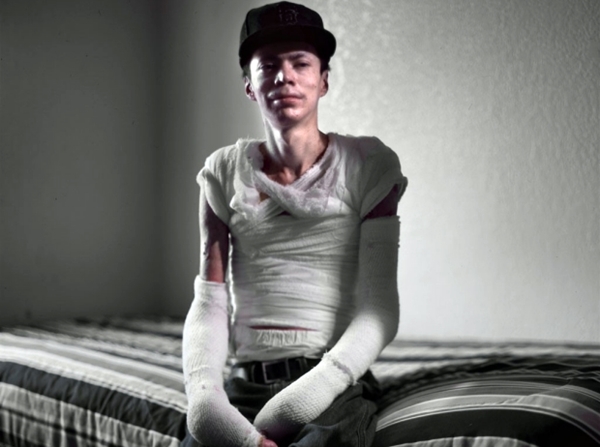
Paul Martinez, a participant in the clinical trial testing gene therapy for RDEB (Max Aguilera-Hellweg, Stanford Medicine)
2 November 2016. An early clinical trial shows genetically engineered skin grafts help heal some open wounds and appear safe for individuals with a serious inherited skin disorder. The team from Stanford University medical school published its findings yesterday in Journal of the American Medical Association (paid subscription required).
Researchers led by dermatology professors Peter Marinkovich and Jean Tang are seeking treatments for recessive dystrophic epidermolysis bullosa, or RDEB, a rare inherited condition where individuals cannot produce the type-7 collagen protein needed to anchor together the upper and lower layers of skin. Without this protein, skin becomes highly fragile and easily damaged with blisters and large open wounds. Severe cases can cause death for infants and require supportive care into adulthood for others.
Marinkovich, Tang, and colleagues tested a treatment for RDEB that takes tissue samples with cells from the patients’ outer skin layers, called keratinocytes, lacking the the type-7 collagen protein. These keratinocytes are then genetically altered with healthy COL7A1 genes that produce the collagen protein, delivered by benign viruses. The genetically-altered cells are cultured and grown in the lab to form skin patches that can be grafted over the patients’ wounds.
The paper reported on the clinical trial, an early-stage study of safety and activity in 4 patients enrolled so far, age 18 to 32 with severe RDEB and open wounds of at least 100 square centimeters. Researchers used the treatment technique to prepare 6 skin grafts of about 35 square centimeters each for all 4 participants. The study team looked primarily at signs of adverse reactions to the grafts, but also indications of type-7 collagen production and wound healing, with new anchoring skin cells in the patients at 3, 6, and 12 months after receiving the grafts.
The results show the treatments are safe for patients and well tolerated, with no adverse effects reported including autoimmune reactions. The grafts are shown to encourage healing of the wounds in many, but not all cases. For example, 90 percent of the grafts at 3 months generated type-7 collagen proteins, but that percentage dropped to 42 percent by 12 months. Similarly, 75 percent of the graft sites experienced healing after 3 months, with continued healing dropping to 50 percent after 12 months.
Nonetheless, the researcher are encouraged by the early results. “In some cases,” says Tang in a university statement, “wounds that had not healed for five years were successfully healed with the gene therapy. This is a huge improvement in the quality of life for these people.”
The study team continues to monitor the first patients, and believes it has enough evidence to begin planning an intermediate-stage trial of the grafts to better understand their longer-term effects, with a larger number and more diverse participant population.
Read more:
- Gene Silencing Treatments Licensed for Heart Disease
- Synthetic Viruses in Gene Therapy Licensed for Production
- Orphan Status Granted for Hemophilia Genome Editing
- Gene Editing Negates Sickle Cell to Create Healthy Blood
- Gene Therapy Designed for Muscle Wasting Disease
* * *

 RSS - Posts
RSS - Posts
You must be logged in to post a comment.